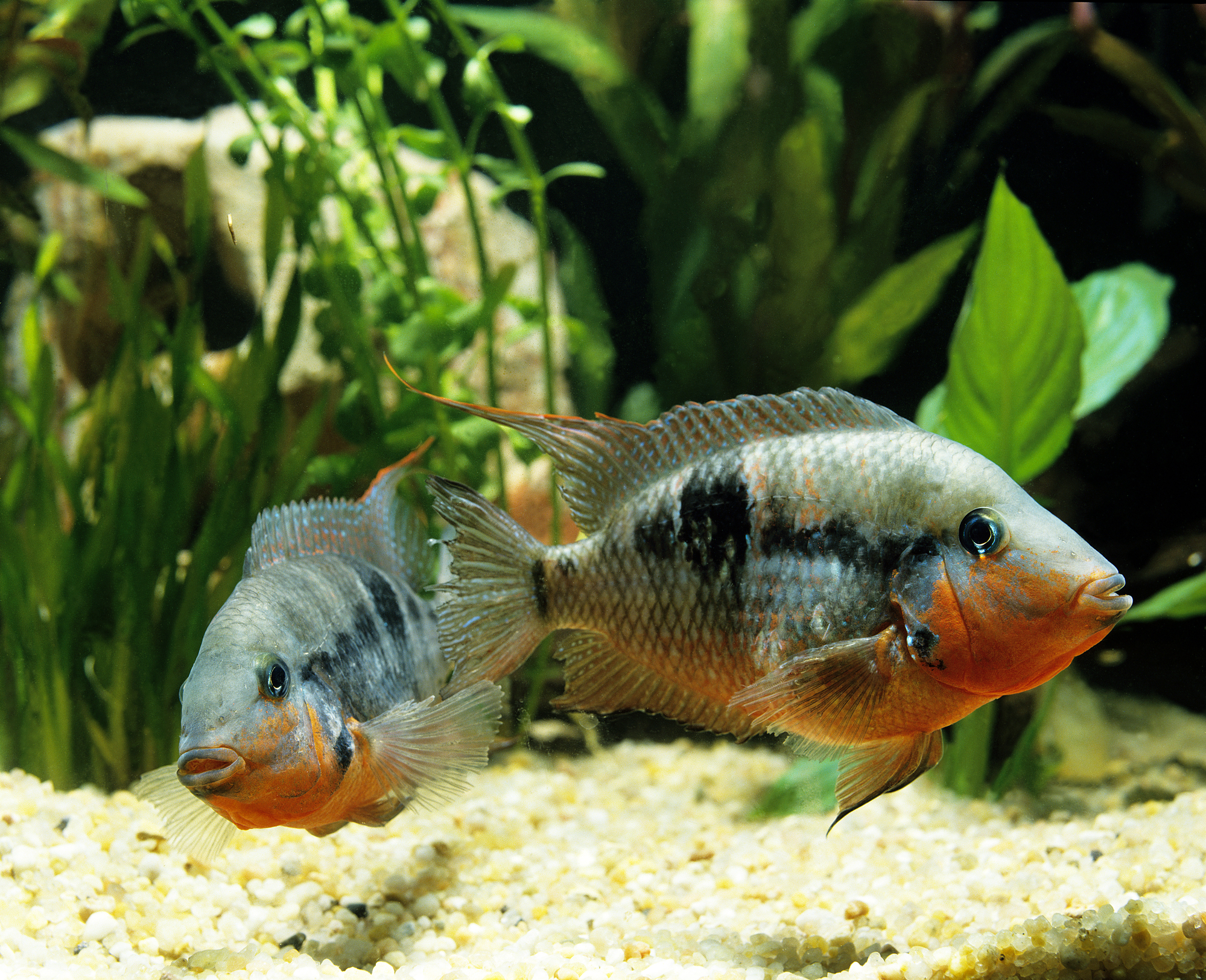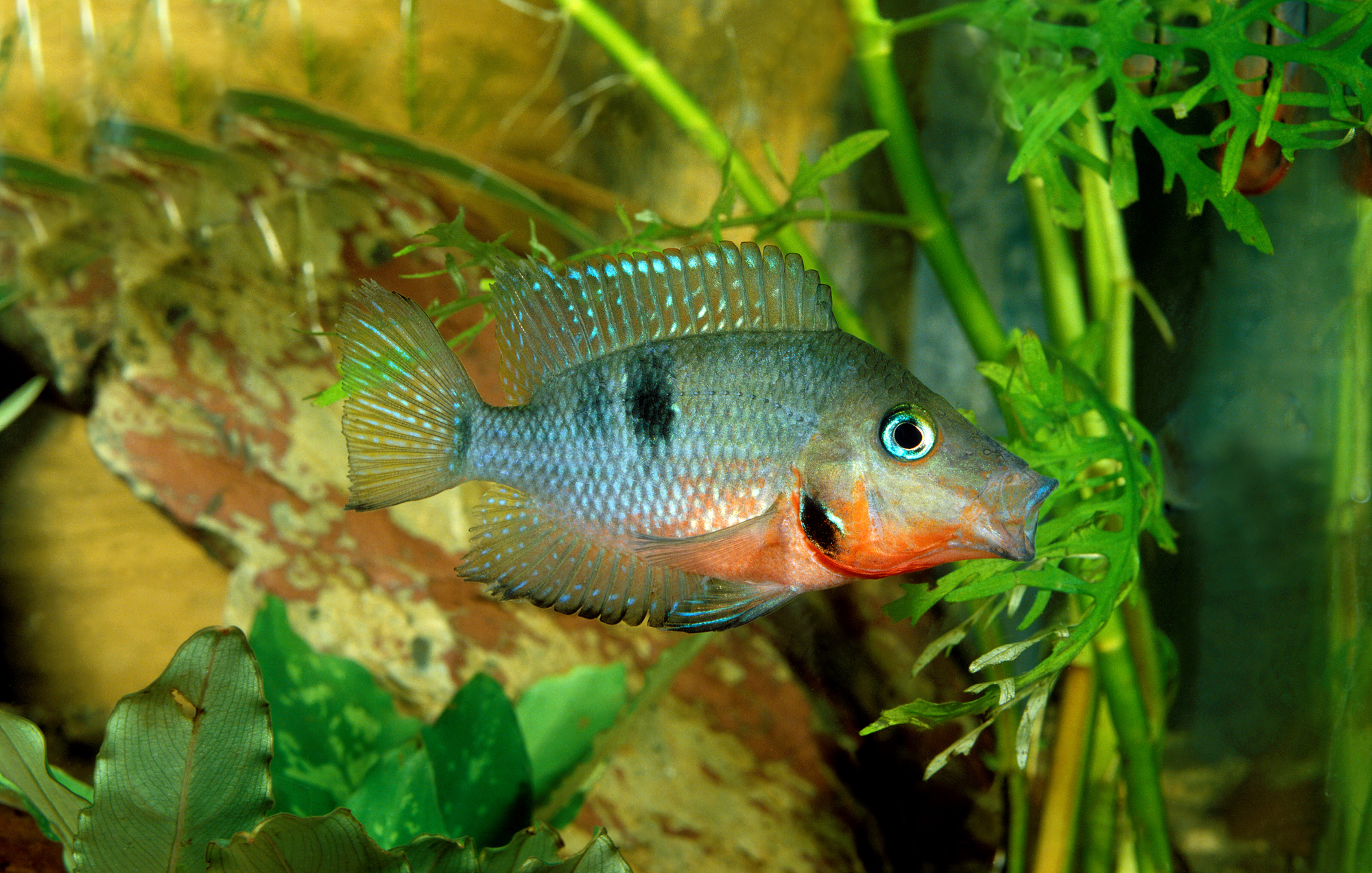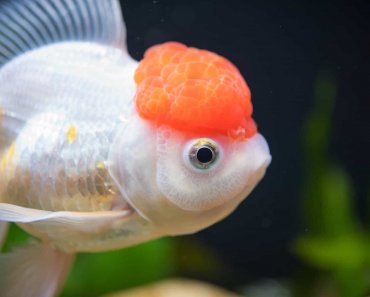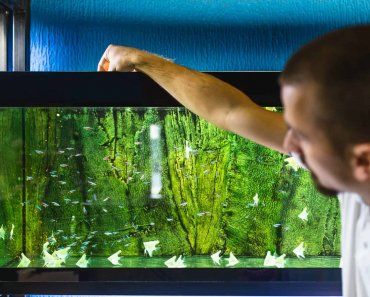With hundreds of different cichlid species to choose from, it can be a little difficult to narrow down the perfect one for your tank. The firemouth cichlid is a type of semi-aggressive cichlid from Central America whose brilliant fiery colors match its sometimes territorial behaviors. These fish are especially hardy and could be a great gateway fish into the semi-aggressive and more aggressive species available in the freshwater aquarium trade.
Keep reading to find out everything you need to know about firemouth cichlid care and keeping one of these fish in your own aquarium!
Name
Thorichthys meeki is commonly known as the firemouth cichlid. They are part of the Cichlidae family, along with their close relatives, African cichlids. However, Thorichthys meeki is distinguished even further into the Cichlinae subfamily, which contains cichlids only native to South America.
Even differentiated further, Thorichthys meeki is part of the Thorichthysgenus, which only includes those cichlids found in very specific locations of slow-moving waters in between the Chachalacas River in Mexico and the Motagua River in Guatemala and Honduras. This genus is only made up of 9 species as of June 2020.
Natural habitat
Firemouth cichlids are mainly native to the Yucatán Peninsula of Mexico, but can also be found in waterways throughout the northern regions of Belize and Guatemala. These fish are found in slow-moving and shallow waters, which can range in salinity (completely freshwater to slightly brackish) and turbidity (completely clear to muddy). These bodies of water include cenotes, streams, ditches, and smaller river tributaries.
The substrate also greatly varies, from being composed of sand to mud to limestone. Aquatic vegetation is usually sparse in these areas, with species of algae mostly replacing typical freshwater foliage. Firemouth cichlids can also be found hiding in broken tree branches and other rock formations.
Invasive species
The firemouth cichlid has found its way into many outlying waterways far from its home in Central America where it has since become a prevalent invasive species. Thorichthys meeki has been reported in Florida, Arizona, Hawaii, and Puerto Rico; however, the populations in Florida have since diminished in recent years and the sighting in Arizona may have been a singular event.
In Hawaii though, populations were deliberately established in the Nuuanu Reservoir and have thrived for nearly 100 years. It is believed that these fish were introduced by means of aquarium releases and/or that they possibly escaped from commercial fish farms otherwise.

Identification
These tropical fish get their common name from the striking red/orange coloration they have on their underbellies and underneath their jaw. On the upper half of these fish is a more greyish-green base color with darker overlaying vertical stripes. They will also have black patches right below their dorsal fin as well as at the base of their operculum (gill cover). Their pelvic, caudal, dorsal, and anal fins may have accents of iridescent blue, but their pectoral fins will not; they may also have some shimmers of this same color along their mid-lateral line across their body.
Adult firemouth cichlids can easily be sexed, making breeding with established pairs easier than some other freshwater fish. Males will have longer dorsal and anal filaments and will have brighter and more vibrant coloration during spawning periods; males tend to be larger in general while females will have rounder bellies.
How big do firemouth cichlids get?
The male firemouth cichlid stays relatively small and will only grow to about 6-7 inches (15.2-17.8 cm) with females only reaching 4-5 inches (10.2-12.7 cm). With proper cichlid care, these fish can easily live to be 10-15 years old, though it is much more common to see shorter lifespans despite excellent care.
Firemouth cichlid tank requirements
Though these fish don’t grow to be very large, they require the same cichlid care and consideration as other related species which can make planning your dream aquarium a little more difficult. In order to keep your firemouth cichlid as happy and healthy as possible, you will want to replicate their natural environment as much as possible in your aquarium.
If wanting to keep a pair of firemouth cichlids, a 30 gallon (113.6 L) will be the bare minimum. If you want to keep other fish with your firemouth cichlid, then at least 55 gallons (208.2 L) should be allowed to keep aggression down.
In the wild, these fish are found in water that has a slow current and sparse vegetation. This means that in the aquarium, these fish will need little to no extra water movement besides that which comes from the filter. Most hobbyists choose not to plant vegetation in their cichlid aquarium as most of the time, they are uprooted and otherwise destroyed. However, if you do want to try introducing live plants into your firemouth cichlid tank, some hobbyists have had luck with leaving Sagittaria in a pot so that the roots aren’t exposed.
Instead, these fish will much prefer pieces of driftwood and other aquarium-cured branches that are naturally positioned to provide shading and places to hide. The substrate should be sandy and intermixed with larger and smoothed rocks. Less natural decorations, like ceramic flower pots and plastic piping may also be used to provide additional hiding spots throughout the tank.
If desired, these fish can also be kept in a brackish aquarium. For some brackish water tank mate ideas, make sure to check out our list of 6 interesting brackish water fish here!
Water parameters
Though the firemouth cichlid is found in a variety of locations and ecosystems, they are still pretty exact about their preferred water parameters. These fish do especially well in more established tanks and should never be placed into a newly cycled system. Regular aquarium maintenance is required, with monthly filter media exchanges and biweekly water changes in order to keep water parameters in check.
The firemouth cichlid will need a stable water temperature between 70-82° F (21.1-27.8° C) with pH between 6.5-8.0. If housing your firemouth cichlid in brackish water conditions, make sure to keep salinity stable as well.
Firemouth cichlid tank mates
While the firemouth cichlid is labeled as a semi-aggressive tropical fish, these cichlids are actually one of the more friendly species and can be put with some community freshwater fish. Some good tank mates might be:
Severum cichlid (Heros severus). Also known as the banded or hero cichlid, these fish are commonly compared to the discus (Symphysodon genus) due to the wide variety of colors they come in. Severum cichlids can grow to be about 10 inches (25.5 cm) and will need a 100 gallons (378.5 L) if kept with other fish to control aggression.
Blood parrot cichlid. One of the most popular cichlid hybrids is the blood parrot; these fish are appreciated for their plump stature and vibrant red-orange bodies. These fish can grow anywhere between 7-10 inches (17.8-25.4 cm) and have been known to live past a decade old! They tend to be shy for their size and can be outcompeted during feeding times. It is recommended to keep blood parrots in at least 55 gallons (208.2 L) with other freshwater fish.
Yoyo loach (Botia almorhae). Loach might not be your first idea as firemouth cichlid tank mates, but these fish are actually the perfect size for not being seen as food! These beautifully black-striped fish will grow to about 5-6 inches (12.7-15.2 cm) long and will stay towards the substrate and low water column of the aquarium. Remember, they will need to be kept on a soft substrate to prevent their underbellies from getting injured.
Giant danios (Devario aequipinnatus). While the giant danio may look like a bigger and more colorful version of the zebra danio (Danio rerio), the two schooling fish have very little in common. Giant danios can grow to be 4 inches (10.2 cm) long and tend to be a little aggressive. Giant danios are popular tank mates as they tend to help firemouth cichlids to display more of their natural behaviors.
Colombian tetras (Hyphessobrycon columbianus). These fish look just like mini piranhas with their red fins and bluish-silver bodies. Colombian tetras can grow up to 2.6 inches (6.6 cm) and like to shoal with other species of tetra; however, they are more aggressive than most other species of tetra, so make sure that temperaments match between fish.
Diamond tetras (Moenkhausia pittieri). If you’re looking for a more ornamental tetra, then the dazzling diamond tetra will shimmer just right. These 2 inch (5.1 cm) fish are simple on their own but look spectacular in a school. Their safety in numbers will keep your firemouth cichlid from going after them while providing excitement and movement to the upper and middle portions of the water column.
Some hobbyists have found that keeping at least four or more firemouth cichlids tends to bring out their best personalities. However, these fish can become especially aggressive and territorial during spawning periods, and changing behaviors should be carefully noted to avoid potential fights. These fights can be avoided by having a large enough tank, providing extra hiding places, and making sure that the fish are well fed with a high-quality diet.
Tank mates that you should avoid
A firemouth cichlid will not hesitate to eat a smaller fish, like small species of tetra or rasbora. They also tend to eat shrimp and snails, though some hobbyists have had luck keeping them with larger snails especially.
One of the most common questions to come across is: Can Central/South American cichlids be kept with African cichlids? The short answer is no, they cannot. The firemouth cichlid is actually one of the less-aggressive species of cichlid from Central America currently available in the aquarium trade, however, this does not mean that they are compatible with African cichlids.
The topic of mixing Central/South American cichlids with African cichlids is highly discussed within the aquarium trade, with no concrete answer being found; the two fish come from completely different ecosystems, and would never normally be found together; this means that they will have differing aquarium needs in terms of water parameters and dietary requirements. However, some hobbyists have had success keeping specific Central/South American species with specific African species.
Not only will the aquarium requirements differ between the species, but aggression will also play a huge role. Since they do not occur in the wild together, there is no way to predict how the fish will react to each other’s presence. Sadly, this usually ends up in a very hostile environment where one or more fish needs to be removed.
In short, we do not advise keeping Central/South American and African cichlids together in the same tank even if the aquarium might seem large enough to comfortably house the two. There are plenty of other Central/South American species that would do great with your firemouth cichlid instead!
Firemouth cichlid behavior
As with all cichlids, special consideration should be given when setting up cichlid-dominated systems. For the most part, these fish will stay in the middle water column. When in groups, they tend to loosely move and interact with each other given adequate swimming space.
Are firemouth cichlids aggressive?
While the fremouth cichlid is considered to be one of the less-aggressive species of Central/South American cichlids, they still exemplify typical cichlid aggression during spawning periods. During these times, they become especially aggressive and are more likely to harass and possibly kill other fish. Because of this, they should only be kept with cichlid-compatible tank mates as listed above.
Firemouth cichlid diet
Firemouth cichlids are omnivores and will need a mixed diet of plant- and animal-based foods. Luckily, these fish tend to eat anything that they happen to come across, making feeding times a little easier.
If your aquarium has a sandy substrate, you may see these fish taking scoops of substrate into their mouths and then expelling the sand through their gills; this is a form of filter-feeding that allows them to remove and digest any detritus that was mixed into the substrate. If you have live plants in your aquarium that have exposed roots, you may also see your firemouth cichlid picking at them (or just come home to a planted tank that doesn’t any plants anymore!).

What do firemouth cichlids eat?
However, you should never rely on the food that naturally occurs in your tank, like that from substrate detritus or plant roots, to be the main diet for your fish. Firemouth cichlids should be offered an assortment of live, frozen, and dried foods, like worms (earthworms, bloodworms, Tubifex worms), brine shrimp, and fish flakes/pellets. Though high-quality fish flakes/pellets should be enough to satisfy the plant-diet aspect of your fish, you may also occasionally offer blanched vegetables, like lettuce, zucchini, or cucumber.
Since offering live foods can get expensive and inconvenient at times, it is recommended to culture your own foods in a separate tank. One of the easiest solutions to this is growing your own brine shrimp, which you can read more about here!
Breeding firemouth cichlids
One of the most rewarding aspects of owning cichlids is watching them pair up and breed. When it comes to breeding, these fish form monogamous relationships and tend for the fry together. It should be noted that younger and more inexperienced breeding pairs may eat or abandon their first spawns if threatened or otherwise stressed.
Firemouth cichlids have been known to breed on their own initiative, without any water parameter or tank condition manipulation. However, if your fish don’t seem to be willing to try on their own, there are a few ways to influence more favorable spawning conditions. The first step is successfully forming a breeding pair. This can easily be done by either sexing each adult cichlid or getting a larger group of them when they are younger and allowing them to naturally pair off as they grow.
Eggs are usually deposited on flat surfaces, like on pieces of driftwood or even on the side of the tank; a female firemouth cichlid can lay up to 500 eggs at a time which will then be fertilized by the male. The female tends to stay the closest to the eggs, while the male will defend the general vicinity of the nest.
It is recommended to remove the pair or the other tank mates from the tank to prevent your other fish from becoming harassed; this will also allow more control over feeding and monitoring the overall wellbeing of the eggs and fry. The eggs will hatch and become free-swimming after several days. At this point, they should be fed high-quality foods like nauplii and microworms. At the same time, the parents will continue caring for them until they are large enough to defend themselves.
Conclusion
The firemouth cichlid is one of the less-aggressive species of Central/South American cichlids, however, special cichlid care and consideration still need to be given. These fish can be kept in more of a community-type setting and even do well with other Thorichthys meeki, but should never be kept with smaller freshwater fish and may eat shrimp and other invertebrates. Breeding these fish can offer good insight for beginners who might want to try breeding more difficult cichlid species in the future.
If you have any questions about firemouth cichlid (Thorichthys meeki) care or have kept these fish in your own aquarium, don’t hesitate to leave a comment below!


























